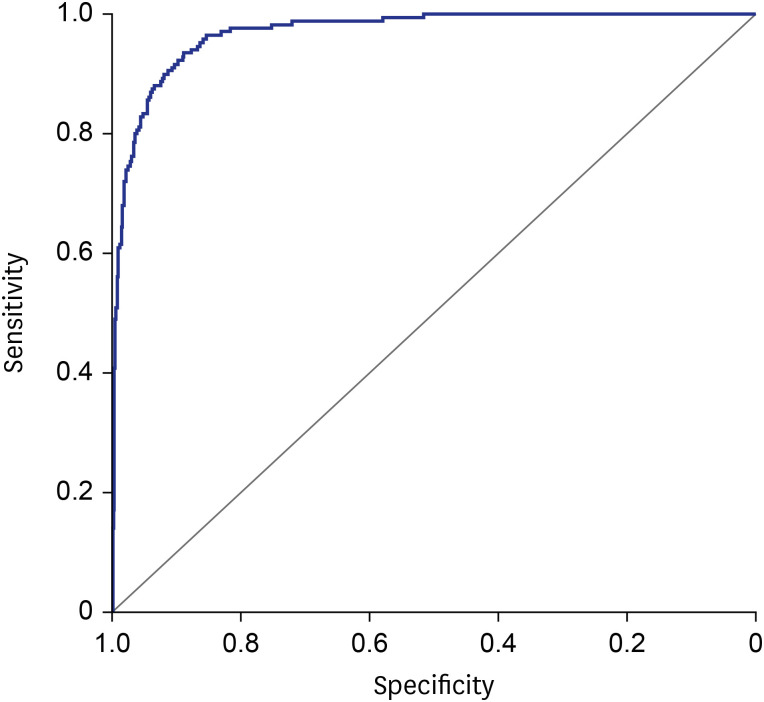J Korean Med Sci.
2021 Apr;36(15):e108. 10.3346/jkms.2021.36.e108.
A Clinical Risk Score to Predict In-hospital Mortality from COVID-19 in South Korea
- Affiliations
-
- 1Division of Cardiology, Department of Internal Medicine, Kangwon National University School of Medicine, Chuncheon, Korea
- 2Department of Biomedical Engineering, College of Information-Bio Convergence Engineering, Ulsan National Institute of Science and Technology (UNIST), Ulsan, Korea
- 3Division of Cardiology, Department of Internal Medicine, Ulsan Medical Center, Ulsan, Korea
- 4Department of Cardiology, Dong-A University Hospital, Busan, Korea
- 5East Lancashire Hospitals NHS Trust, Blackburn, Lancashire, UK
- 6Division of Cardiology, Department of Internal Medicine, Ulsan University Hospital, University of Ulsan College of Medicine, Ulsan, Korea
- KMID: 2515042
- DOI: http://doi.org/10.3346/jkms.2021.36.e108
Abstract
- Background
Early identification of patients with coronavirus disease 2019 (COVID-19) who are at high risk of mortality is of vital importance for appropriate clinical decision making and delivering optimal treatment. We aimed to develop and validate a clinical risk score for predicting mortality at the time of admission of patients hospitalized with COVID-19.
Methods
Collaborating with the Korea Centers for Disease Control and Prevention (KCDC), we established a prospective consecutive cohort of 5,628 patients with confirmed COVID-19 infection who were admitted to 120 hospitals in Korea between January 20, 2020, and April 30, 2020. The cohort was randomly divided using a 7:3 ratio into a development (n = 3,940) and validation (n = 1,688) set. Clinical information and complete blood count (CBC) detected at admission were investigated using Least Absolute Shrinkage and Selection Operator (LASSO) and logistic regression to construct a predictive risk score (COVID-Mortality Score). The discriminative power of the risk model was assessed by calculating the area under the curve (AUC) of the receiver operating characteristic curves.
Results
The incidence of mortality was 4.3% in both the development and validation set. A COVID-Mortality Score consisting of age, sex, body mass index, combined comorbidity, clinical symptoms, and CBC was developed. AUCs of the scoring system were 0.96 (95% confidence interval [CI], 0.85–0.91) and 0.97 (95% CI, 0.84–0.93) in the development and validation set, respectively. If the model was optimized for > 90% sensitivity, accuracies were 81.0% and 80.2% with sensitivities of 91.7% and 86.1% in the development and validation set, respectively. The optimized scoring system has been applied to the public online risk calculator (https://www.diseaseriskscore.com).
Conclusion
This clinically developed and validated COVID-Mortality Score, using clinical data available at the time of admission, will aid clinicians in predicting in-hospital mortality.
Keyword
Figure
Reference
-
1. Wu F, Zhao S, Yu B, Chen YM, Wang W, Song ZG, et al. A new coronavirus associated with human respiratory disease in China. Nature. 2020; 579(7798):265–269. PMID: 32015508.
Article2. Li Q, Guan X, Wu P, Wang X, Zhou L, Tong Y, et al. Early transmission dynamics in Wuhan, China, of novel coronavirus-infected pneumonia. N Engl J Med. 2020; 382(13):1199–1207. PMID: 31995857.
Article3. Richardson S, Hirsch JS, Narasimhan M, Crawford JM, McGinn T, Davidson KW, et al. Presenting characteristics, comorbidities, and outcomes among 5700 patients hospitalized with COVID-19 in the New York City area. JAMA. 2020; 323(20):2052–2059. PMID: 32320003.
Article4. Liang W, Liang H, Ou L, Chen B, Chen A, Li C, et al. Development and validation of a clinical risk score to predict the occurrence of critical illness in hospitalized patients with COVID-19. JAMA Intern Med. 2020; 180(8):1081–1089. PMID: 32396163.
Article5. Altschul DJ, Unda SR, Benton J, de la Garza Ramos R, Cezayirli P, Mehler M, et al. A novel severity score to predict inpatient mortality in COVID-19 patients. Sci Rep. 2020; 10(1):16726. PMID: 33028914.
Article6. Gao Y, Cai GY, Fang W, Li HY, Wang SY, Chen L, et al. Machine learning based early warning system enables accurate mortality risk prediction for COVID-19. Nat Commun. 2020; 11(1):5033. PMID: 33024092.
Article7. Zhou F, Yu T, Du R, Fan G, Liu Y, Liu Z, et al. Clinical course and risk factors for mortality of adult inpatients with COVID-19 in Wuhan, China: a retrospective cohort study. Lancet. 2020; 395(10229):1054–1062. PMID: 32171076.
Article8. Vincent JL, Moreno R, Takala J, Willatts S, De Mendonça A, Bruining H, et al. The SOFA (Sepsis-related Organ Failure Assessment) score to describe organ dysfunction/failure. On behalf of the Working Group on Sepsis-Related Problems of the European Society of Intensive Care Medicine. Intensive Care Med. 1996; 22(7):707–710. PMID: 8844239.9. Yadaw AS, Li YC, Bose S, Iyengar R, Bunyavanich S, Pandey G. Clinical features of COVID-19 mortality: development and validation of a clinical prediction model. Lancet Digit Health. 2020; 2(10):e516–25. PMID: 32984797.
Article
- Full Text Links
- Actions
-
Cited
- CITED
-
- Close
- Share
- Similar articles
-
- Associations Between COVID-19, Delirium, and 1-Year Mortality: Exploring Influences on Delirium Incidence in COVID-19 Patients
- Incidence and Mortality Associated with Cardiovascular Medication among Hypertensive COVID-19 Patients in South Korea
- COVID-19 and Cancer: Questions to Be Answered
- Clinical and Radiologic Findings of COVID-19 Pneumonia: South Korean Experience from Three Cases
- New Scoring System for Predicting Mortality in Patients with COVID-19



